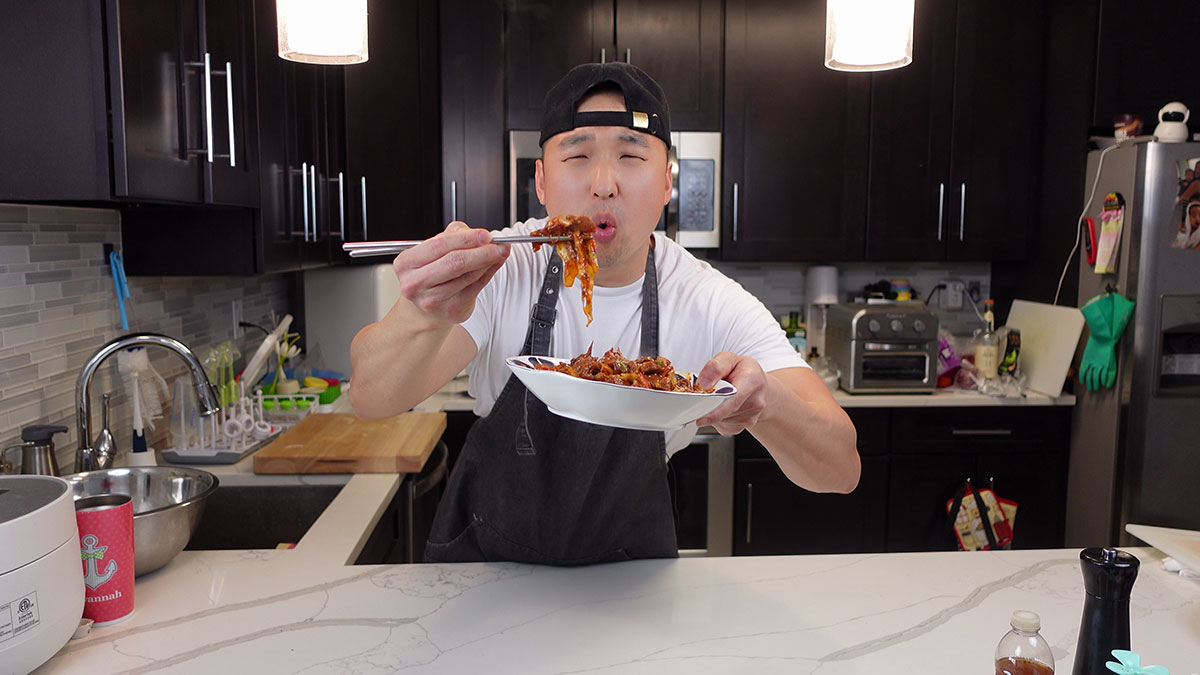
Jeyuk Bokkeum is a classic Korean recipe that a lot of people always request. Many times, people would message me and ask if I could share my recipe for this dish that they’ve tried out in a Korean joint near them.
Luckily, while this may be called different names like Korean Spicy Pork, Pork Bulgogi, or Dwaeji Gogi – this is one of the easiest dishes you can remake. With simple vegetables and some Korean pantry essentials on hand, you can enjoy this spicy and savory dish in 30 minutes or less!
How to Make Korean Spicy Pork?
Disclaimer: I get a small commission at no additional cost to you when you make a qualified purchase under the affiliate links.
The Pork

When cooking this dish, I like using pork shoulder butt or moksal. The main reason is that it has a good amount of fat in between the meat or “marbling” which means it remains juicy after cooking it. You can also use pork belly, although best if using one that has thinner and alternating layers of fat. Pork is a must in this dish! Chicken may be great in a spicy stir fry, but that may need a different recipe altogether.
When you’re at Hmart or any Asian market, you may see packs of thin, pre-sliced moksal which is also okay to use. However, personally, I find that those tend to still be thick, so I prefer slicing my own very thinly and bite-size. This way, it’s also easier to cook.
TIP: To make it easy to slice, freeze the pork for 30-45 minutes to firm it up. You’ll get better slices because it won’t be flimsy. Do use a sharp knife as well so you can cut through the meat easily.
The Vegetables
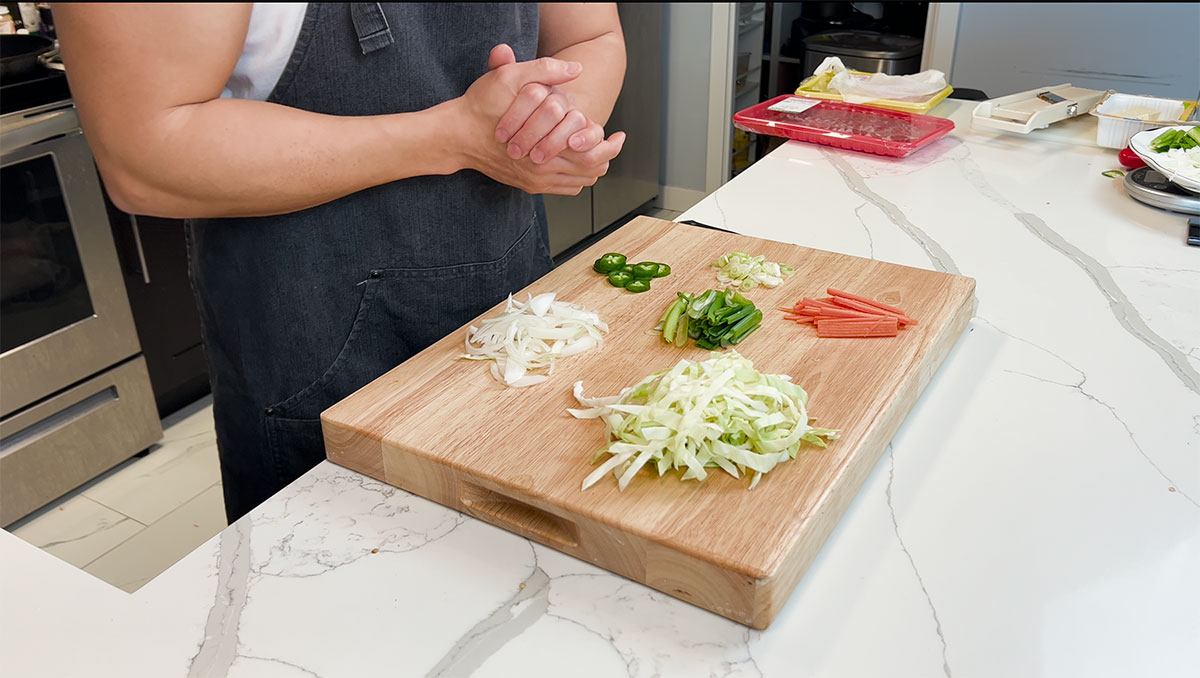
In my opinion, one of the things that makes this dish one of the best is that it has a good amount of vegetables that get infused with the oil rendered from the pork.
The vegetables you can use are cabbage, carrots, onion, scallions, and jalapeno (if you want an extra kick). If you don’t like any one of these, just use less or completely opt out. Just make sure to use about 300-350 grams of veggies in total to match the pork. It may sound like a lot, but it will cook down.
Slice them julienne or use a mandolin to make them equal matchstick sizes. This way you can grab it all with the chopsticks in one go. Also, remember not to overcook your vegetables. Stir fry them until they are cooked but still crisp!
TIP: To take it up a notch, add kimchi to your Jeyuk Bokkeum. Stir-frying it will make all that kimchi flavor develop and become a cherry on top of your dish!
The Spicy Sauce
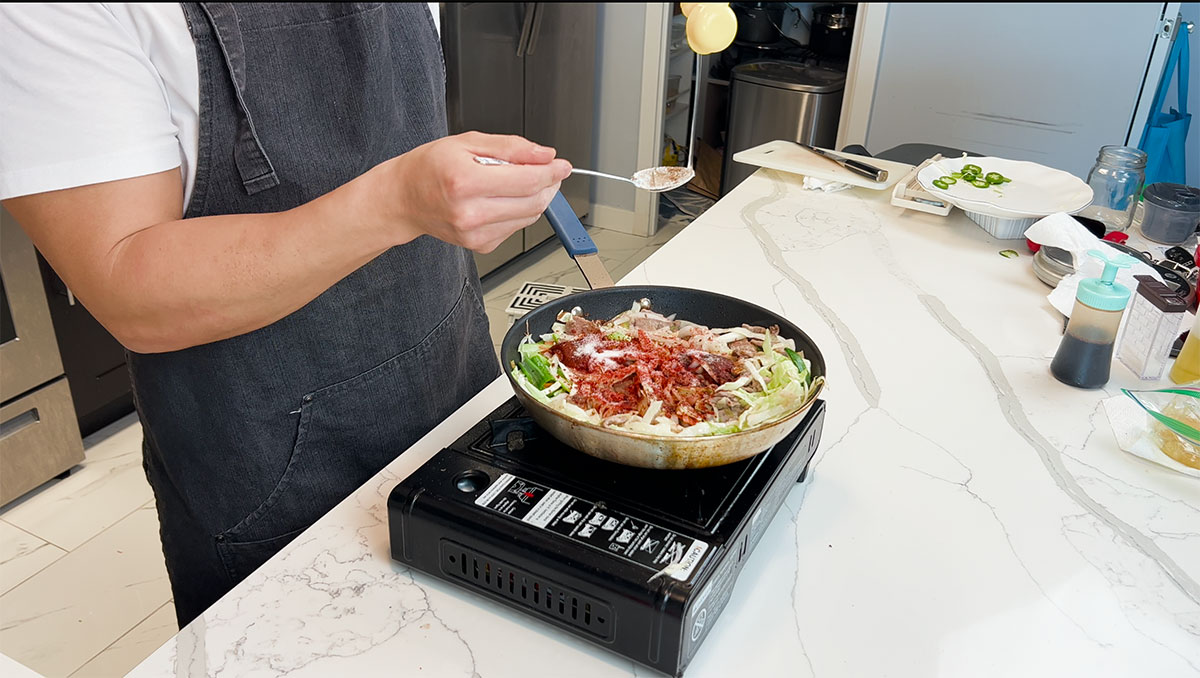
For the sauce, you will be using several Korean pantry essentials so you may need to make a trip down the nearest Hmart or Asian grocery to make this dish.
- Korean Red Pepper Paste (Gochujang) – This is the base of the sauce where the spice and savor will come from. This is essential to the whole dish.
- Korean Red Pepper Flakes (Gochugaru – Coarse) – This will give a smoky, sweet, and spicy touch to the dish. You can opt to put less if you want to tone down the spice.
- Korean Red Pepper Powder (Gochugaru – Fine) – Essentially, this is just a finer version of the coarse pepper flakes and it has the same flavor profile. I like adding this to stir the pork fry a boost in color. It may be confusing when you go to the supermarket as they can come in the same packaging with different labels. But if you can’t find the “fine powder”, then the coarse pepper flakes are good to go.
- Soy Sauce – Use any light or regular soy sauce. This will boost the flavors and complement gochujang. With this, you wouldn’t have to use any more salt. If you want to lessen the spice, tone down on the pepper paste, flakes, and powder, and add more soy sauce.
- Sesame Oil and Sesame Seeds – The condiments I like to add to fried rice and stir-fries. A small amount will do and will give the dish a smoky and nutty finish.
- Sugar and Corn Syrup – These sweet components balance out the spice from the gochujang and gochugaru. If you don’t have corn syrup, just use sugar. Alternatively, if you want this low carb, you can replace these with sugar substitutes. Either way, the sweetener is also an essential ingredient in this dish.
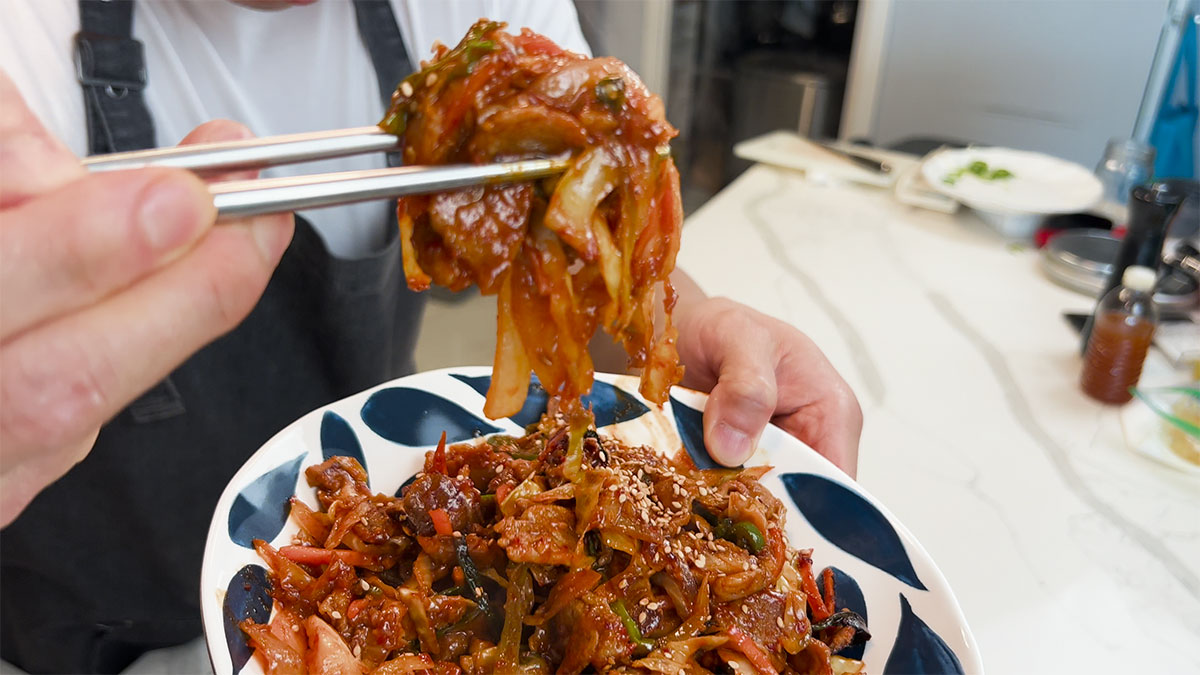
A secret ingredient I like to add here is 1/2 tablespoon of plum sauce and two tablespoons of apple juice. A small amount of these will give acidity and sweetness that will balance all the spice. Optional, but chef recommended!
Aside from using this sauce for jeyuk bokkeum, you can also use this as a marinade for any pork for your DIY Korean BBQ.
TIP: In the restaurant, we typically cook this in a wok, so it has a distinct flavor coming from that very high heat. However, if you are doing this at home and don’t have a wok, you can remake those flavors by torching your jeyuk bokkeum. Torch it until it gets really good caramelization and smokiness!
How to Serve Jeyuk Bokkeum?

This is a savory dish, so it is best served with anything neutral like rice, noodles, or boiled tofu. My wife likes adding udon when we eat this!
If you wanna be extra, serve on the sizzling plate so the dish stays hot and gets an extra crust. Enjoy!
Other classic Korean dishes you might like:
Make sure to leave a rating, a comment, or tag me on Facebook, Instagram, or Tiktok when you chop them up! Yeobosayo!
Korean Spicy Pork Stir Fry (Jeyuk Bokkeum)
Equipment
- Blow Torch
Ingredients
- 350 grams Pork Shoulder Butt Sliced thinly
- 200 grams Cabbage Sliced julienne
- 100 grams Onion Sliced julienne
- 25 grams Carrots Sliced julienne
- 3 stalks Scallions Chop white part, slice to 3-in pieces the green part
- 1 pc Jalapeno Optional
- 1/2 tbsp Garlic
- 2 tbsp Korean Red Pepper Paste or Gochujang
- 1 tbsp Red Pepper Flakes
- 1/2 tbsp Red Pepper Powder
- 1 tbsp Soy Sauce
- 1 tbsp Sesame Oil
- 1 tbsp Sugar
- 1 tbsp Corn Syrup
- Sesame Seeds
- Black Pepper To taste
- Vegetable or Canola Oil For sauteing
Instructions
- Prepare the pork and the vegetables.
- Combine gochujang, pepper flakes, pepper powder, soy sauce, sesame oil, sugar, corn syrup, sesame seeds, and black pepper. Mix thoroughly and set aside.
- In high heat, saute garlic and pork with a bit of oil.
- When the pork is 70% done, mix in the vegetables and mix thoroughly.
- Add the sauce and mix thoroughly.
- Stir fry for 3-4 minutes more or until the vegetables are cooked but still have crunch. Do not overcook.
- To give it a grilled taste, torch the spicy pork until there are several burnt marks.
- Plate and top with some more sesame seeds.
- Serve with rice or noodles and enjoy!

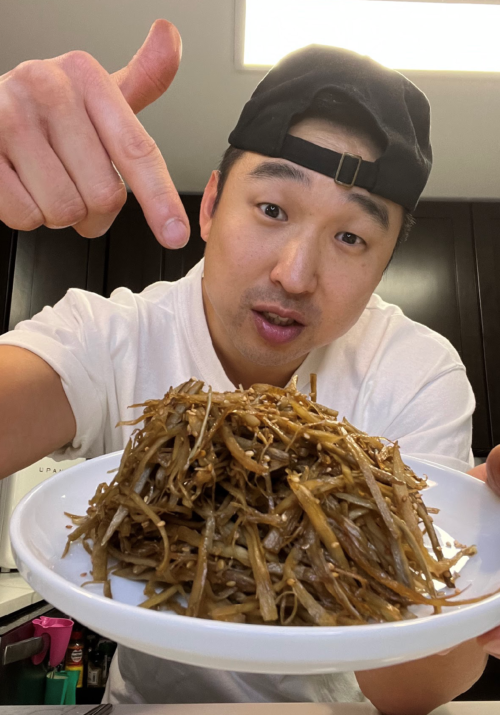
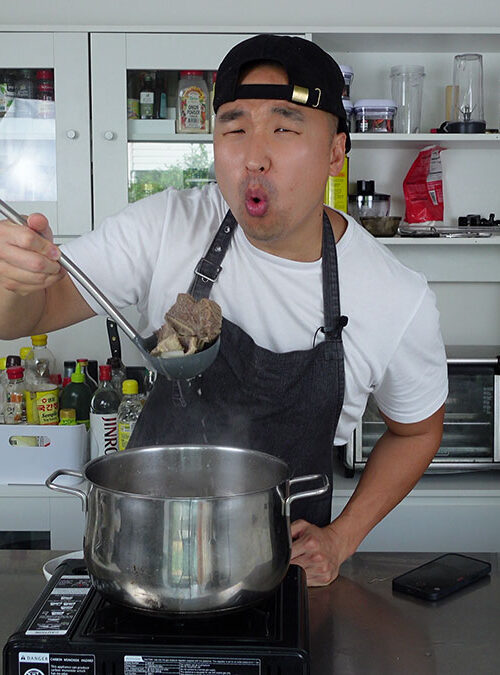
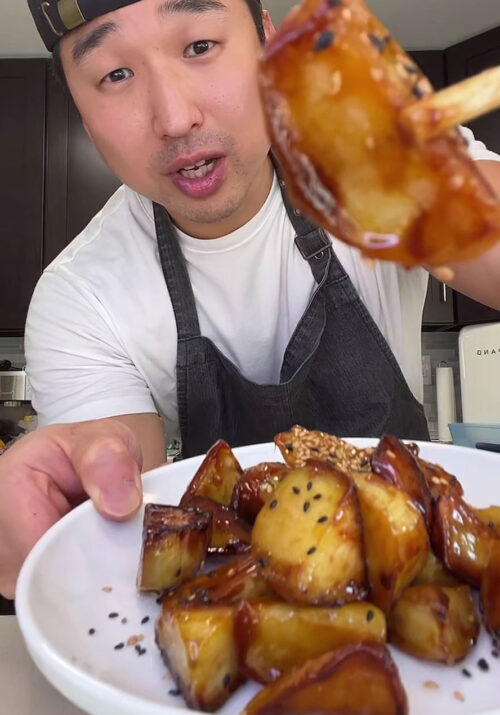


Love your recipes.
Thank you Barbara!!!
Chef, this recipe was both simple and delicious. My first attempt at making a Korean dish was a huge hit. Im looking forward to trying more. THANK YOU!!
I’m so happy you enjoyed them!! More easy and delicious recipes here on the site, looking forward to hear how you like them!
Outstanding! made a keto version by replacing the sugar with erythritol – best dinner for a while!
Great job!! When I was doing Keto I used to do that to my recipes too, and they work out great!
Made it doubled sauce recipe and mixed with ramen !!!BOMB!!!
YEOBOSAYO!!!!
Hi Chris
Greetings from Scotland!
You can’t get corn syrup here so substituted it for honey and otherwise cooked as exactly as per your recipe and video. Totally delicious.
Thanks
Stuart
So glad it worked out well for you!
Loved this recipe! It was exactly like the Jeyuk Bokkeum at the KATUSA snack bar on Camp Casey in Tongducheon! Brought back memories.
Yeobosayo!! So glad you liked the recipe!!
The closest I have come to the Camp Stanley Katusa snack bar spicy pork! I may have to cut back a bit on the red pepper flakes, but it really was fabulous.
YEOBOSAYO!!!! 🥳
I had some thinly sliced boneless pork chops in the freezer that I used for this recipe. It was delicious, even if my meat was a bit chewier than it would have been with a cut of pork with more marbled fat. I had no corn syrup so I used a dash of maple syrup…not authentic, I know, but yum!
So glad you worked through the recipe with what you have, that’s what cooking is all about! And so happy you enjoyed it!!
I forgot to give it a rating: five stars!
Thank you so much!!!